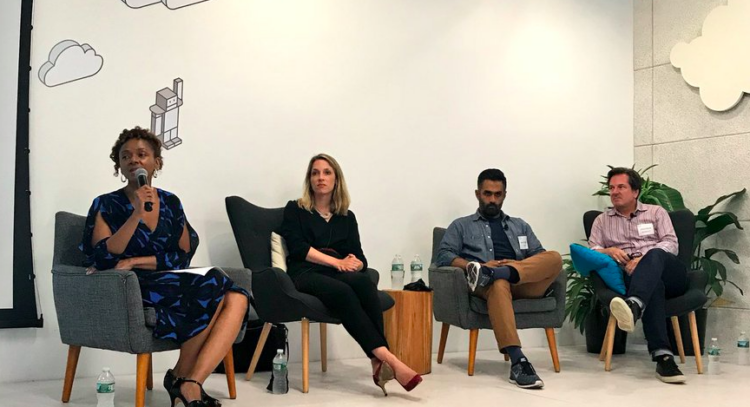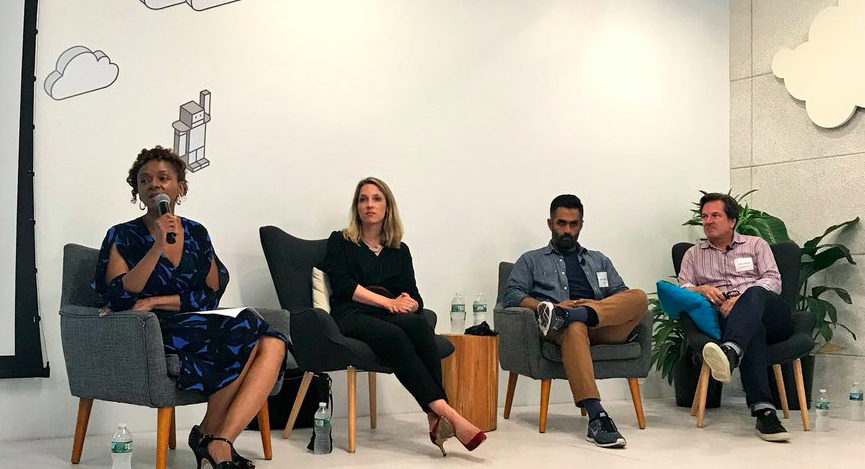It is well established that startups have a difficult time building diverse teams. Especially at the earliest stages, founders recruit and hire people in their personal networks including former classmates, colleagues, and friends. This often results in a homogenous workforce that can become self-fulfilling over time without intentional efforts and course correction.
At the most recent NYC Blend event, the panelists agreed that it’s never too early to think about how to create a diverse and inclusive workforce. We brought together three NY-based companies at various stages to share how they have recruited and retained talent from diverse backgrounds:
- Amit Khanna, General Counsel, Knotel
- Caroline Hofmann, COO and Cofounder, Republic
- Chris Davis, CFO, Managed by Q
- Chymeka Olfonse, Founding Regional Executive Director at BUILD NYC (moderator)
Our recap below highlights some of the specific tactics and strategies shared by our panelists on how their companies successfully hire people from diverse backgrounds.
Change must come from the top
- Leadership should champion these D&I initiatives and hold managers accountable. It cannot be one person’s responsibility.
- There must be a budget associated with these changes (e.g. higher referral bonuses for candidates from underrepresented backgrounds).
Look into alternative recruitment channels for targeted recruiting
- There are local organizations that focus on tech skills development and placement. For example, one of the hourly employees at Managed by Q qualified for the Coalition for Queens (C4Q) program. After completing the C4Q program, she was hired as an engineer at Managed by Q.
- Republic attends events like Lesbians Who Tech and posts jobs on Werk, which shares career opportunities with an audience of professionals looking for flexible work.
- Knotel sponsored a hackathon in Brooklyn with FWD.us focusing on immigrants rights and advocacy and also partnered with the Center for Economic Opportunities (CEO) to hire formerly incarcerated persons.
- Other sources of talent from diverse backgrounds may include: professional societies (e.g., American Bar Association), networking groups (e.g., NY Tech Meetup), alumni clubs of universities (e.g., CUNY)
Evaluate data to assess unconscious bias
- Avoid quotas but track this data in order to see the complete story.
- Be careful of being a resume snob, or looking for certain schools or pedigrees for certain jobs. One example of bias was not taking coding boot camp graduates seriously. You may consider blocking out unnecessary resume information such as name, university, GPA, address, demographically-identifying information (e.g., leader of a demographically-oriented club). Look for high performance over prestige.
- Use tools such as Textio to evaluate your job descriptions for bias.
Retain talent through internal development and support
- It’s important to retain this talent once they join the company. Companies should make sure these individuals are set up for success by investing in individual growth and providing mentoring, training, and development opportunities.
- Employee surveys assessing engagement, inclusion, and job satisfaction could be used to surface internal issues or team dynamics. Companies may also consider providing unconscious bias training to the entire company as part of their internal development programming.
- Employee Resource Groups (ERGs) may have different focus areas depending on the target population (e.g. Latino/Black groups may focus on recruiting, while women groups focus on development, and LGBTQ groups focus on inclusion).
- Offboarding interviews can help bring to light cultural issues or barriers.
Consider diversity more broadly
- Are there other forms of under-representation within your organization such as employees from diverse age groups (e.g. ageism)?
- Can you engage third parties in your D&I goals (e.g. asking investors, law firms, and recruiters to share data on their D&I performance and selecting vendors with this as part of your criteria).




